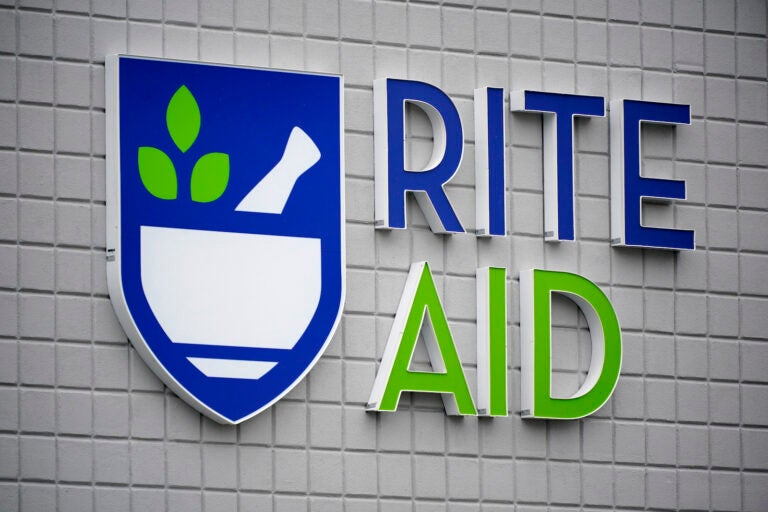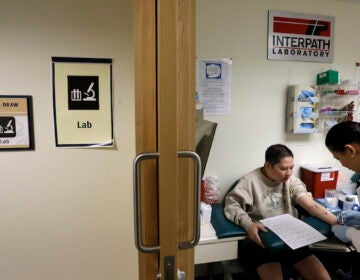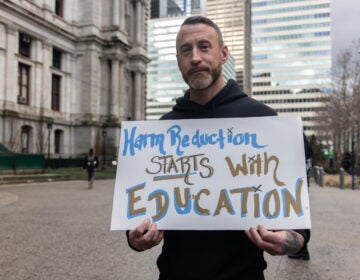For Rite Aid customers in the Philly region, finding a new pharmacy might prove challenging
Local pharmacists are beginning to feel the weight of Rite Aid’s closures, and some might not be able to take on more patients.
Listen 1:10
This photo shows a sign of Rite Aid on its store in Pittsburgh on Jan. 23, 2023. (AP Photo/Gene J. Puskar, File)
Please tell us about your experiences with pharmacies in the Philadelphia region. What should we know?
Finding a pharmacy in their neighborhood may soon become more challenging for many Philadelphia-area residents.
On Thursday, drugstore chain Rite Aid announced an additional 31 branches closing across a dozen states — three in the Philadelphia region, including South Jersey.
The Philadelphia-based company is in the middle of a large-scale restructuring plan, which started with filing for Chapter 11 bankruptcy protection in October.
There are now 18 Rite Aid pharmacies shuttering throughout the Delaware Valley, and some health experts believe that the trajectory will continue to spiral downward.
“I think that labor challenges are hitting pharmacists. Getting technicians is a major issue right now for me,” said Shawn Parekh, vice president and chief pharmacy officer for Temple Health.
Staff shortages are having a serious impact on pharmacies nationwide, from independently-owned neighborhood stores to bigger chains like Rite Aid, said Parekh, who called the situation “Pharmageddon.”
While it’s not uncommon for pharmacies to sell, or go out of business, Parekh said that over the course of his career, he’s never seen a closure of this magnitude.
“Not at this level. Not these mega chain stores,” he said. “I’m a little surprised that it happened so suddenly and so drastically.”
A devastating blow to the Philadelphia region
Rite Aid’s shrinking footprint in the Delaware Valley is a huge loss to the region, specifically in Philadelphia, Parekh said.
“They were always here. I feel like that’s critical,” he said. “We know we have major access issues. I don’t see a whole lot of other chains out there. I see a lot of independent pharmacies, but I always saw Rite Aid. Whether I was walking in Philadelphia or driving on Broad Street, I saw Rite Aid.”
This, among many other reasons, is why health experts are concerned about how Rite Aid’s closures could worsen the continuous rise of “pharmacy deserts” around the country.
In 2021, a University of Southern California study showed that more Black and Latino communities had fewer pharmacies than white or diverse neighborhoods. Larger U.S. cities, like Philadelphia, were impacted most.
What Rite Aid did well was maintaining the presence of a big chain drugstore within neighborhoods underserved in the region, Parekh said.
“They set up the pharmacies in areas that were much needed and that was the most important thing,” he said.
Shopping for another pharmacy will not be easy
With the Rite Aid closures, which happened abruptly, Parekh said it’s very likely that some customers will not have enough time to find alternative solutions.
“There could have been more effective communication with some of those local pharmacies to roll over these prescriptions ahead of time, to let those providers know — physicians, NPs PAs, etc. — that, ‘Hey, we’re closing. You need to think about alternative strategies for your patients.’ That partnership was critical.”
He said the process of rolling over scripts can be arduous.
“Even I struggle sometimes to get an appointment or to manage my medications with the pharmacy,” Parekh said.
But Ben Nachum, owner of Patriot Pharmacy in North Philadelphia, said he hasn’t been contacted by Rite Aid pharmacists regarding prescriptions since the closures.
He’s already seeing an influx of patients trying to move their prescriptions over to his business from a Rite Aid.
“There are people who have called saying, ‘I have my stuff at Rite Aid, can you call and transfer it over,” he said. And for most residents, Rite Aid has not helped them in their search for a new pharmacy.
“I think the consideration for a neighborhood like ours is that people in these neighborhoods don’t always have the same phone number,” Nachum said. “They probably robo-called the numbers in their systems, but that’s not really putting out an effort. I have people in my store whose numbers change like once every couple months.”
He’s also seeing that some prospective customers are getting their scripts moved to areas that are far away for them.
“It just happened yesterday,” he said. “Someone who’s in my neighborhood, her scripts got moved, but it’s not close. So we had to call Rite Aid, and because the Rite Aid is now moving all their stuff, their pharmacists are overwhelmed.”
Expect to be turned away
The most difficult challenge for Nachum is turning people away. He said he’s forced to make tough decisions because he cannot afford to buy a stockpile on certain drugs.
“On most everything, like insulin, or Ozempic, a wonderful drug because it’s phenomenal for diabetics, it’s very expensive,” he said. And not only does he not make any money on these drugs — he actually loses money.
“What ends up happening is if I bring in that over from a Rite Aid, and it’s under one of these major pharmacy benefits managers, I will probably lose 90 to 100 dollars just on that one prescription,” he said.
This is an unfortunate reality for many pharmacies, said Rob Frankil, executive director of Philadelphia Association of Retail Druggists (PARD), an organization of independent pharmacy owners and associates.
PARD has about 300 members representing approximately 250 independently-owned pharmacies statewide.
“Hardly a week goes by that one of my members does not contact me and say, ‘I just can’t make it. I got to figure out a way to sell my pharmacy. I’m underwater. I’m losing money. I owe money,’” Frankil said.
Moving forward, he said it’s more likely that customers coming from Rite Aid will be referred to small, independently-owned pharmacies. He fears that those owners will have to make the hard decision to turn people in need away.
“What’s happening now with pharmacies is if they’re smart business people, they are going to take a look at that patient,” he said, “and chances are they’re going to make a judgment based on the insurance companies’ pay and the reimbursement from that plan if that patient is going to bring in profit or not.”
And the latter is probably more plausible.
“The chances are, with the way the reimbursements are nowadays, pharmacies are probably going to lose money on that patient,” he said.
With this, he said, the same issues affecting Rite Aid on a large scale might soon trickle down to smaller drugstores, and further perpetuate pharmacy deserts in the region and nationwide.
“Independent pharmacies in those same neighborhoods are not going to be able to make it for the same reasons if not more,” he said. “Now you have a concern about pharmacy deserts and people in neighborhoods like Kensington who now might have to go a mile or two to get their prescriptions filled.”
Support for WHYY’s coverage of health equity issues comes from the Commonwealth Fund.

Get daily updates from WHYY News!
WHYY is your source for fact-based, in-depth journalism and information. As a nonprofit organization, we rely on financial support from readers like you. Please give today.







